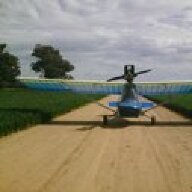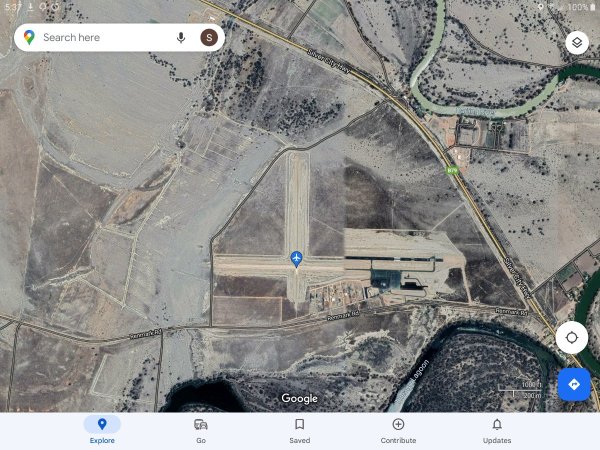-
Posts
3,050 -
Joined
-
Last visited
-
Days Won
64
Content Type
Profiles
Forums
Gallery
Downloads
Blogs
Events
Store
Aircraft
Resources
Tutorials
Articles
Classifieds
Movies
Books
Community Map
Quizzes
Posts posted by Thruster88
-
-
I watched the same, skywagon university, a great YouTube channel.
My baby Beechcraft 23 has the same system. It is just a spring inter connect between the rudder and aileron. To be honest I don't think about it while flying the mighty Musketeer. It is easy to over power if you want full rudder without any aileron input.
The seats in the Musketeer have that same arm chair feel as the debonair very comfortable at a much lower speed, love it.
-
 2
2
-
-
I have never experienced nosewheel shimmy in the RV, the break out force is 10kg at the axle. After a few hours you forget about the castoring nosewheel, it just works.
-
 1
1
-
 1
1
-
-
They might be pitching over with almost zero g as the load comes out.
-
My RV has a heavy Hartzell CS prop and with just me and full fuel the CG is at the forward limit. RV6 has a small tail. The farm strip is bare earth and I nearly always have a look at the touch down marks after landing. Always land with the stick well or fully back however the nose will always touch within 5 metres of the mains. Cant keep it off and I don't try to when taking off, I like a positive rotation at the correct speed, departure stalls suck big time.
The nose leg on the RV is plenty strong enough, it is the same type as the other legs on nosewheel and tail wheel RVs. If it can support the weight in the hangar it can support the weight going 50-60knots down the runway.
So why do they bend?
I think it may be some form of violent shimmy. We have a long spring with a heavy piece (nosewheel, fork and spat) on the end. Imagine the aircraft lands in a crab or the free castoring nose wheel is at a slight angle at touch down, it flicks to one side and then on the next touch it binds slightly and drives the nose leg sideways, repeat a few times and the leg bends.
A few years ago there was one at Narromine with the leg bent out the side, it got me thinking why is it so.
The one at William Creek had an after market reinforcement, it did not say what type in the ATSB report.
What can we do.
Correct nosewheel tyre pressure, Van's recommended 25-35, they say less is better, I use 25psi.
Correct breakout force on the nose leg, 10kg for my aircraft.
No side slips on final, we want that free castoring tyre to be straight at touch down.
Land it like you are doing a wheel landing in a tail wheel aircraft, smooth, straight, no crab touch and a slight pin, we don't want that free castoring nose wheel skipping about.
-
 2
2
-
-
There is no doubt, it was a departure stall. Cannot fault this reporter, correctly described type of aircraft and operation.
-
 1
1
-
-
On 23/01/2023 at 9:33 PM, trike1 said:
As a soon to be RV flyer what size/type of crash axe should I have at hand?
I have a small cross pein hammer in my 6a. It is held in place by the seat velcro and should be easy to access if required. I have tested it on aircraft plexiglass and it works very well.
-
 1
1
-
-
3 hours ago, Mike Gearon said:
Very good. It’s quite flat where the incident happened. Tail wind was a major factor. Nothing wrong with the runway.
Was landing in the opposite direction possible or not due to slope? As an RV nosewheel operator I am curious if they were able to break the canopy and escape without outside help.
-
 2
2
-
 1
1
-
-
I use same Samsung charger/ cable that is used for my tablet and phone. SkyEcho2 can take about 5 hours to charge.
-
 1
1
-
-
Stuck valve relief?
-
20 hours ago, Kiwi55 said:
Hi,
2 Freak failure. We had a Rotax carb heat system fitted on the engine (original factory fit). It uses a extra assy fitted to the outside of the muffler which has circular spacer rings separating the outside of the muffler from the inside of the heater sleeve.
One of the these ring collapsed and a piece found it's way right through the carb system into the no.1 cylinder. Not good.
Now the Zongshen looks attractive.
Are you sure that carburetor heat muff is a genuine Rotax part? The parts books I have looked at do not show one.
The last Rotax 912 annual I did was a Foxbat A22. It had air cleaners inside the air box so no dirt or shrapnel can ever enter the engine regardless of hot or cold selected. Good engineering.
-
 2
2
-
-
Hard to understand how this can happen in a two pilot aircraft equipped with stick shaker and stick pusher. Runaway trim?
-
 1
1
-
 1
1
-
-
11 hours ago, pmccarthy said:
I have resisted paying for YouTube subscription which claims to remove ads. Has anyone done it, and does it?
I have a premium subscription, worth every cent. Only ads are those presented by the creator, example Trent Palmer will talk about square space in his videos.
-
 1
1
-
 1
1
-
-
54 minutes ago, coljones said:
I have a 2 yo Samsung tablet, RWY and SkyEcho2. The combo can be set up to pick up both ASSB and OzRunways traffic. If you, also, get the Speedify app it works like a breeze. The OzRunways knowlege base has a variety of details
I must be doing something wrong. Just tried ozrunways with SkyEcho2 at home on my new Samsung phone, have mobile coverage but can't get oz traffic and adsb traffic at the same time. Knowledge base has no info for android on this issue.
-
I have a 5yo Samsung s3 tablet, ozrunways and SkyEcho2. Has always worked.
I do lose the ozrunways telstra delivered traffic when the tablet is wifi ing with the SkyEcho2. Suspect this is due to age of tablet not being able to do both?, it is a 3g unit, old.
-
 1
1
-
-
Runaway trim is a MEMORY item. Not a 737 pilot but I know the location and function of the 2, yes two, trim cut out switches that have been fitted every model of 737.
We have nothing to fear flying in a jet in Australia.
-
 1
1
-
 1
1
-
 1
1
-
-
Flow rate through an orifice will be dependent on diameter and to a great extent the length of orifice.
The 0.35mm carb jet would have minimal length and could have a similar flow to a 0.5mm drilled hole that is say 2 or 3mm "long".
Only a flow test will will determine actual performance of any orifice in the system.
-
 2
2
-
-
There is avgas available in all directions 60nm from Tooraweena. Mogas is available at wings out west 60nm south of Tooraweena.
I WOULD NOT BE PUTTING FUEL IN EX CHEMICAL DRUMS. Have heard of some not so good results.
-
 1
1
-
 1
1
-
-
Rylstone has some. https://rylstoneaerodrome.com.au/
Cowra is Hangars only. http://www.cowraairport.com.au/airport-project
-
49 minutes ago, biggles said:
First light at Porepunkah 4/1/23 … 5.29 AM….. BobIt's a cessna 172 apparently so pilot could have night VFR or instrument rating.
-
 1
1
-
-
17 minutes ago, Bruce Tuncks said:
I too would like to know much more about the engine failure. At the beginning of the take-off run, you know that you have 2 working ignition systems and 2 fuel pumps. AND your engine, if DI'd according to the makers, had compressions on all 4 cylinders.
How could the engine have failed ?
It has been said this aircraft had only been flown twice in the previous 12 months. Why? If that is true, why the pilot flew in the heat with a passenger in a direction/height that would result in a tree landing if the engine failed is probably the more important question. Alot of RAAus accidents are the result of poor decisions.
-
 1
1
-
 4
4
-
-
My 2 cents worth. Clear pics on Facebook show glassy water in all pics indicating light winds. There is a fire truck about 100m behind the aircraft, most likely on the end of runway 35, so takeoff to the north on the shorter runway, could be wrong but seems to fit the pics. Runway 26, 1400 meters, has no obstacles to clear. Always do a pre takeoff briefing to self. Both runways are sealed now.
-
 1
1
-
 1
1
-
-
Maybe Ec130 heli is flown from left seat single pilot.
-
 1
1
-
-
If only they had kept the cockpit doors locked before 911.
-
 1
1
-
-
38 minutes ago, old man emu said:
Better to ask politely for people to approach in an orderly manner than have them come from every which-way. At least if people approach along the same path, it makes it easier to "See & Be Seen" Or am I a fool who thinks that normal people are happy to cooperate?
Yes however they will be coming from every which-way to the initial "approach point". Aircraft could be going head to head as they turn towards the airport. Then there could be over taking on the confined approach path. It will also add to radio calls required and they will no longer be standard.
With normal CTAF circuit procedure everyone should approach with the runway on their left and only turn left as they descend into the circuit
All the Nat fly, Ausfly, Old Station etc events have used standard circuit procedure.
-
 2
2
-





Instrumentation for a 2 stroke
in Instruments, Radios and Electronics
Posted
If it is a rotax, 503? with the factory recommended jets in the carburetor(s) then as a completely satisfied operator of rotax 377,503 and 582 engines for 38 years now just need RPM. Fuel pressure is next thing I would add.